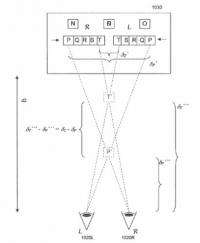May 13, 2012 report
Sony patent seeks to correct autostereoscopic blur

(Phys.org) -- Sony has filed a patent with the U.S. Patent & Trademark Office for a glasses-free 3-D display that will adjust the picture so that the user gets an optimal view no matter how far or close to the screen. In its application, “Stereoscopic Image Processing Method and Apparatus,” Sony defined its patent intent: “A stereoscopic image processing method for a stereoscopic image pair forming a 3-D image comprises the steps of evaluating whether the distance of a user is closer or further than a preferred distance from a 3-D image display upon which the stereoscopic image pair is to be displayed, and if the evaluation indicates that the user is further than the preferred distance from the 3-D image display, adjusting the respective displacements between corresponding image elements in the stereoscopic image pair, thereby changing the stereoscopic parallax in the 3-D image.”
What this means is that Sony is planning to resolve the disadvantages of no-glasses 3-D viewing in the home. Critics have often noted blurring and other compromised effects that make the 3-D viewing experience less than desired just because the viewer is not in the best position. The success of autostereoscopic (glasses-free) 3-D has depended highly on the viewer’s angle and distance from the screen. With Sony’s 3-D viewing concept, the application would be able to detect a user’s distance from the screen and adjust the separation of images accordingly.
Sony points out past technology limitations of 3-D viewing with no glasses in its patent: “3-D content is recorded using a stereoscopic camera having a fixed arrangement of lenses that presuppose a corresponding fixed viewing position.” The problem, says Sony, is that the effect of being in the wrong place for viewing is discouraging. According to the patent, “the reproduced image can feel unnatural and in extreme cases may lead to headaches or nausea.” Sony says one particular weakness is under- or over-exaggeration of depth, depending on how near or far the user is from the screen.
The patent is for both an image-processing method and an entertainment system for the image display. The patent says that Sony’s technology involves shifting image elements in at least one of the left-eye and right-eye images to change the size of displacements, as a function of existing displacements, and the point of intersection of lines of sight between the corresponding image elements and the viewer. The separation in depth between different image elements is substantially the same as it would have been if the user had been viewing the video at the ideal distance.
Sony’s patent does not represent the first attempt of a company seeking to evolve non-glasses 3-D viewing. Cebit in 2010 in Hanover, Germany, is a case in point. Technology companies at Cebit created a stir showing efforts toward a new breed of displays. Sunny Ocean Studios had a panel fitted to a standard display, sending out a stereoscopic image to 64 positions around the screen. That meant you would be able to “run around” and see a nice 3D display, said Armin Grasnick of Sunny Ocean, at the time. Another company, SeeFront, showed a display moving with the viewer’s eyes, with the viewer always seeing the 3-D image. Eye-tracking has been an essential component of its glasses-free 3-D display technology, according to SeeFront.
© 2012 Phys.Org





















